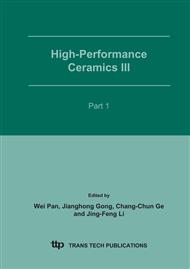p.895
p.899
p.903
p.907
p.911
p.915
p.919
p.925
p.929
Pretreatment of the TaSiN Substrate Surface for Copper-MOCVD
Abstract:
Effects of plasma pretreatments to the TaSiN film surface on Cu nucleation were investigated. Scanning electron microscopy (SEM) was used to measure the Cu nucleation density and to observe the morphology of the Cu film. X-ray spectroscopy (XPS) and Auger depth profiling analyses were used to investigate the bonding state of atoms and the concentrations of oxygen and nitrogen at the TaSiN film surface, respectively. Cu nucleation in Cu MOCVD is effectively enhanced by treating the underlying Ta-Si-N film surface with hydrogen plasma prior to Cu MOCVD. The Cu nucleation density in Cu MOCVD increases as the rf-power and the plasma exposure time increase in the hydrogen plasma pretreatment, but it is saturated at the rf-power of 40W and the plasma exposure time of 2min. To increase the rf-power and the plasma exposure time further would increase the plasma radiation damage for the Si substrate. Therefore, 40W and 2min are the optimal process conditions for the hydrogen pretreatment. Copper nucleation is enhanced by hydrogen plasma pretreatment because the plasma treatment removes the nitrogen and oxygen atoms from the Ta-Si-N film surface. Since Ta-Si is a substrate more favorable for Cu nucleation than Ta-Si-N(O), Cu nucleation on the Ta-Si-N film is enhanced by hydrogen plasma pretreatment of the Ta-Si-N film surface.
Info:
Periodical:
Pages:
911-914
Citation:
Online since:
February 2007
Authors:
Keywords:
Price:
Сopyright:
© 2005 Trans Tech Publications Ltd. All Rights Reserved
Share:
Citation:


